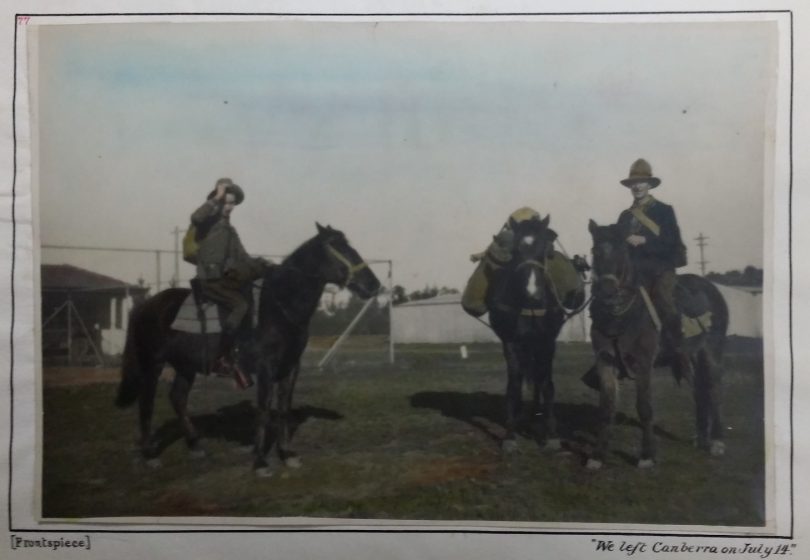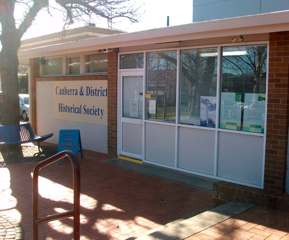
‘Three Hundred Miles with Note-book and Camera’: Photograph in Jefferis-Whelen Journal held at CDHS.
If you’ve never been to the Canberra & District Historical Society (CDHS), you’re missing out. Opened in 1953, the CDHS was set up to protect Canberra’s heritage by collecting and storing materials of interest to the people of Canberra, and promoting local history to the local community.
From their Resource Centre in the Curtin Shopping Centre, CDHS volunteers review, research and study a collection of authentic historical records related to Canberra, such as artworks, photographs, maps, letters and journals.
They regularly facilitate talks, discussions and exhibitions about Canberra’s history and artefacts of interest, and help Canberrans celebrate historic milestones. In Curtin, for example, they ran a series of events for the Curtin 50th birthday back in 2014, interviewing Curtin residents – many of whom had lived there for decades.
CDHS keep archives on all Canberra suburbs and local people of interest, and have files dating all the way back to the early 1920s. Their website has a very interesting page chronicling Canberra’s history from 1820, and they run the Canberra Historical Journal containing articles by local historians twice a year, and a bi-monthly newsletter (Canberra History News) that contains contributions from members.

Keith Carnall Collection at CDHS: Outside the Royal Hotel in Bungendore, 1923.
Julia Ryan, President of Canberra District Historical Society, says that they currently have a number of very interesting projects underway, including an exhibition of historic photographs from the Cricketing Association in the 1920s, and a study of a most exciting journal written by two Canberrans in the 1920s.
“We have three volumes of recollections, which are basically journals written by two men named Jefferis and Whelen,” says Julia. “They lived in Canberra in the 20s and worked in the Hotel Canberra as porters and waiters. In the winter months when Canberra was quiet, they travelled around the Territory taking photographs and drawing pictures.
“Somehow the journals ended up in England in the 1930s, but were sent back to Canberra in the 1980s. They’ve come to us, and ACT Heritage has recently provided a grant so we can make copies of them, study them, and run workshops where the people of Canberra can see and read them.”

Watercolours by George Jefferis – Jefferis-Whelen Journal held at CDHS.
CDHS meet once a month to discuss current topics of interest. At their next meeting, attendees will get a live demonstration of a new addition to the ACT Mapi website, where historical maps can overlay current maps and people can see what their suburb used to look like throughout Canberra’s history.
Last month, Canberra District Historical Society received a $500 grant as part of Curtin Community Bank® Branch’s 5th birthday celebration.
“We’ve banked with Curtin Community Bank ever since the Commonwealth Bank closed down,” says Julia. “We’re very grateful for the grant, which will be used to continue our work and promote the Jefferis and Whelen journals so people in Canberra know about them.”
The CDHS Resource Centre in Curtin is run completely by volunteers and is open Tuesdays 11 am – 5:30 pm, Wednesdays 11 am – 2 pm, and Saturdays 10 am – 12 noon. Julia says they would open more frequently if they had more volunteers, and urges anyone interested in volunteering to get in touch.

CDHS in Curtin: Photograph by Julia Ryan.
There is a small yearly membership fee for those wanting to get involved in the CDHS community and attend monthly meetings. The next meeting will be held Tuesday August 8 in the Menzies Room of the National Archives from 5 – 7 pm, with Aaron O’Hehir presenting a live demonstration of the ACT Mapi historical overlay.
To learn more about the CDHS archives or current projects, or to enquire about volunteering, visit Canberra & District Historical Society or call 6281 2929.
To learn more about Canberra Community Bank® Group grants, pop into any one of their branches in Calwell, Curtin, Jerrabomberra or Wanniassa.
This is a sponsored article, though all opinions are the author’s own. For more information on paid content, see our sponsored content policy.












